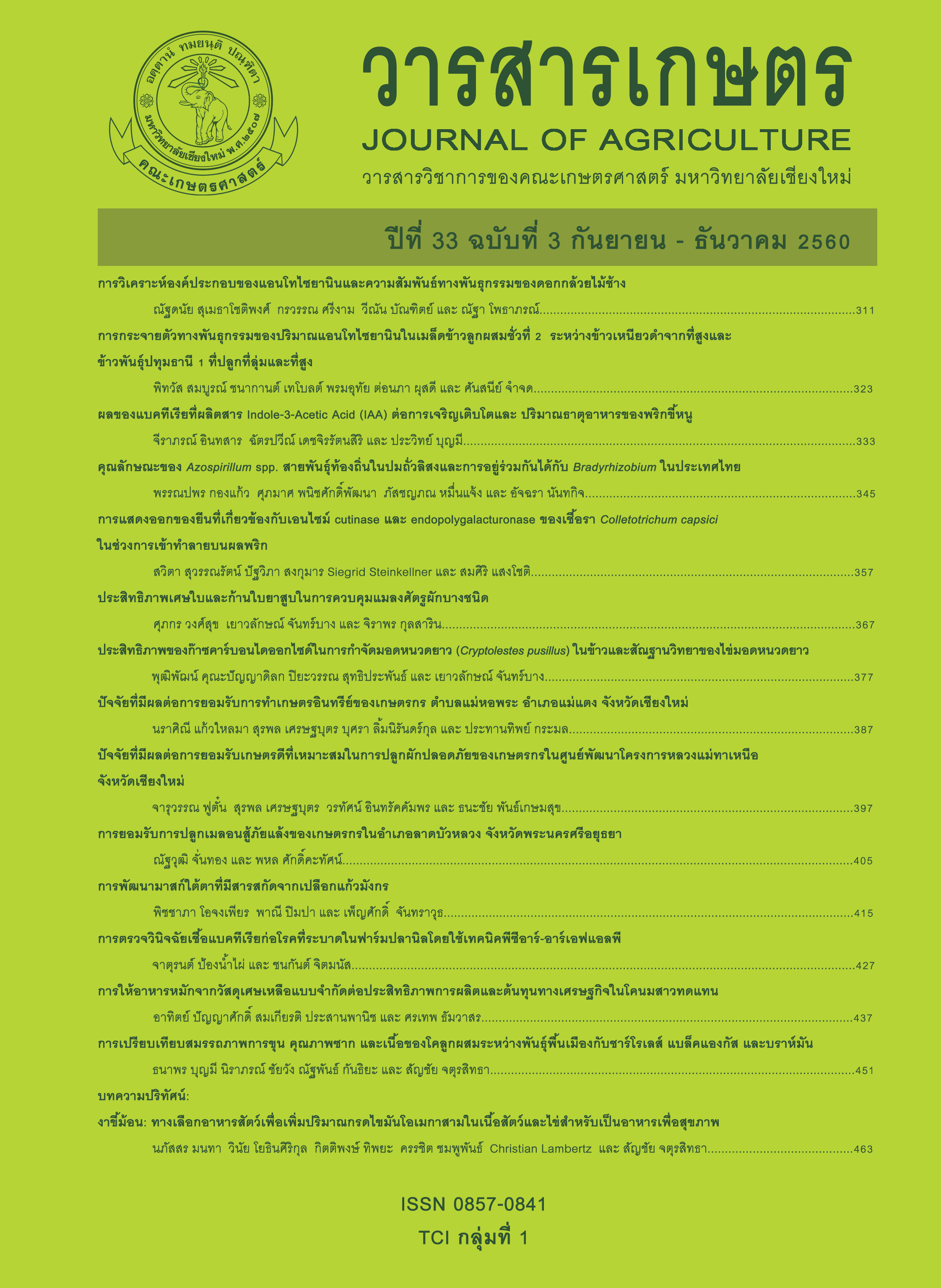ผลของแบคทีเรียที่ผลิตสาร Indole-3-Acetic Acid (IAA) ต่อการเจริญเติบโตและ ปริมาณธาตุอาหารของพริกขี้หนู
Main Article Content
บทคัดย่อ
การศึกษาผลของแบคทีเรียที่สามารถผลิต indole-3-acetic acid (IAA) ต่อการเจริญเติบโตและปริมาณธาตุอาหารของพริก โดยทำการคัดเลือกเชื้อแบคทีเรียจากดินในพื้นที่ของศูนย์พัฒนาพันธุ์พืชจักรพันธ์เพ็ญศิริ จังหวัดเชียงราย ในปี พ.ศ. 2558 พบเชื้อแบคทีเรียทั้งหมด 57 ไอโซเลท โดยมีแบคทีเรีย 15 ไอโซเลท ที่มีความสามารถในการผลิต IAA อยู่ในช่วง 20 ถึง 126 µg/ml จากนั้นทำการคัดเลือก isolate ที่สามารถผลิตสาร indole-3-acetic acid (IAA) ได้สูงที่สุด 6 ไอโซเลท คือ ไอโซเลท 1-ไอโซเลท 6 นำไปทดสอบกับต้นกล้าพริก โดยวางแผนการทดลองแบบสุ่มอย่างสมบูรณ์ (CRD) ประกอบด้วยสิ่งทดลอง 7 ตำรับ จำนวน 4 ซ้ำ คือ 1. ตำรับควบคุม (control) ไม่ใส่เชื้อจุลินทรีย์, ตำรับที่ 2-ตำรับที่ 7 ใส่จุลินทรีย์ที่มีความสามารถในการผลิตสาร IAA ไอโซเลท 1-6 ตามลำดับ ซึ่งเป็นจุลินทรีย์ Bacillus spp. จากผลการทดลองพบว่าการใช้เชื้อแบคทีเรีย ไอโซเลท 1 (Brevibacillus agri) มีความสามารถในการผลิต IAA ได้สูงที่สุดคือ 126 µg/ml ส่งผลให้มีจำนวนใบต่อต้น ความสูง ความยาวราก น้ำหนักสด น้ำหนักแห้งทั้งในส่วนเหนือดินและส่วนของราก สูงกว่าตำรับอื่น ๆ อย่างมีนัยสำคัญทางสถิติ นอกจากนี้การดูดใช้ธาตุอาหารของพริกในตำรับที่มีการใช้เชื้อจุลินทรีย์ ไอโซเลท 1 ทำให้ปริมาณไนโตรเจน ฟอสฟอรัส และโพแทสเซียม ของส่วนเหนือดิน (3.68%N, 0.30%P และ 3.65%K) และส่วนรากมีค่าสูงที่สุด (2.08%N, 0.15%P และ 2.49%K) จากการศึกษาในครั้งนี้พบว่าเชื้อ Isolate ที่สามารถผลิตฮอร์โมน IAA ได้ในปริมาณที่สูงช่วยส่งเสริมการเจริญเติบโตในด้านสรีระทุก ๆ ด้านของพริกขี้หนูสูงกว่าเชื้อกลุ่มที่สามารถผลิตฮอร์โมนได้ในปริมาณต่ำ
Article Details
เอกสารอ้างอิง
จีราภรณ์ อินทสาร ฉัตรปวีณ์ เดชจิรรัตนสิริ และ ประวิทย์ บุญมี. 2559. ผลของการใช้วัสดุปรับปรุงดินร่วมกับเชื้อแบคทีเรียที่สามารถย่อยสลายฟอสเฟตต่อการเปลี่ยนแปลงคุณสมบัติของดินใต้ทรงพุ่มมะรุม. วารสารเกษตร 32(3): 379-390.
ดนัย บุณยเกียรติ. 2539. สรีรวิทยาของพืช. ภาควิชาพืชสวน คณะเกษตรศาสตร์ มหาวิทยาลัยเชียงใหม่, เชียงใหม่.
ธนากร แสงสง่า. 2557. พีจีพีอาร์: บทบาทในการส่งเสริมและป้องกันพืชภายใต้สภาวะเครียด. วารสารวิทยาศาสตร์และเทคโนโลยี 22(4): 553-570.
เนาวรัตน์ ศิวะศิลป์. 2527. คู่มือวิเคราะห์ดิน พืช และปุ๋ย. ภาควิชาปฐพีศาสตร์และอนุรักษศาสตร์ คณะเกษตรศาสตร์ มหาวิทยาลัยเชียงใหม่, เชียงใหม่.
พันทวี มาไพโรจน์. 2532. ฮอร์โมนและสารควบคุมการเจริญเติบโตของพืช: บทแนะนำความรู้พื้นฐาน. ภาควิชาชีววิทยา คณะวิทยาศาสตร์ มหาวิทยาลัยเชียงใหม่, เชียงใหม่.
พีรเดช ทองอำไพ. 2529. ฮอร์โมนพืชและสารสังเคราะห์. ภาควิชาพืชสวน คณะเกษตร มหาวิทยาลัย เกษตรศาสตร์, กรุงเทพฯ.
ลิลลี่ กาวีต๊ะ มาลี ณ นคร ศรีสม สุวรรณวงศ์ และ สุรียา ตันติวิวัฒน์. 2549. สรีรวิทยาของพืช. พิมพ์ครั้งที่ 1. สำนักพิมพ์มหาวิทยาลัยเกษตรศาสตร์, กรุงเทพฯ.
วันเพ็ญ ภูติจันทร์. 2548. สรีรวิทยาทั่วไป (General Physiology). โอเดียนสโตร์, กรุงเทพฯ.
วิลาวรรณ์ เชื้อบุญ และ ดุสิต อธินุวัฒน์. 2557. ฮอร์โมนพืชผลิตจาก Pseudomonas fluorescens SP007s ในการส่งเสริมการเจริญเติบโต ของคะน้าอินทรีย์. Thai Journal of Science and Technology 3(3): 196-205.
อรวรรณ ฉัตรสีรุ้ง. 2545. การผลิตสาร Indole-3-acetic acid (IAA) และ Rhizobitoxine โดยเชื้อไรโซ เบียม. ภาควิชาปฐพีศาสตร์และอนุรักษศาสตร์ คณะเกษตรศาสตร์ มหาวิทยาลัยเชียงใหม่, เชียงใหม่.
Acuña, J.J., M.A. Jorquera, O.A. Martínez, D. Menezes_Blackburn, M.T. Fernández, P. Marschner, R. Greiner and M.L. Mora. 2011. Indole acetic acid and phytase activity produced by rhizosphere bacilli as affected by pH and metals. Journal of Soil Science and Plant Nutrition 11(3): 1-12.
Amaresan, N., V. Jayakumar, K. Kumar and N. Thajuddin. 2012. Isolation and characterization of plant growth promoting endophytic bacteria and their effect on tomato (Lycopersicon esculentum) and chilli (Capsicum annuum) seedling growth. Annals of Microbiology 62: 805-810.
Amirthalingam, S. 1988. Studies on effect of Azospirillum, nitrogen and NAA on growth and yield of chilli (Capsicum annuum L.) cv. K.1. South Indian Horticulture 36(4): 218.
Arshad, M. and W.T. Frankenberger. 1992. Microbial production of plant growth regulators, pp. 307-347. In: F.B.Metting, Jr. (ed.). Soil Microbial Ecology. Marcel Dekker Inc., New York.
Bhandari, S., M. Sajwan and N.S. Bisht. 2009. Physiological effect of auxins on growth characteristics and productive potential of Verbascum thapsus - a medicinal plant. Researcher 1(5): 47-51.
Datta, C. and P.S. Basu. 2000. lndole acetic acid production by a Rhizobium species from root nodules of a leguminous shrub Cajanus cajan. Microbiological Research 155(2): 123-127.
Datta, M., R. Palit, C. Sengupta, M.K. Pandit and S. Banerjee. 2011. Plant growth promoting rhizobacteria enhance growth and yield of chilli (Capsicum annuum L.) under field conditions. Australian Journal of Crop Science 5(5): 531-536.
Egamberdiyeva, D. 2007. The effect of plant growth promoting bacteria on growth and nutrient uptake of maize in two different soils. Applied Soil Ecology 36(2-3): 184-189.
Ehmann, A. 1977. The van Urk-Salkowski reagent - a sensitive and specific chromogenic reagent for silica gel thin-layer chromatographic detection and identification of indole derivatives. Journal of Chromatography 132(2): 267-276.
Etesami, H., H.A. Alikhani and H.M. Hosseini. 2015. Indole-3-acetic acid (IAA) production trait, a useful screening to select endophytic and rhizosphere competent bacteria for rice growth promoting agents. MethodsX 2: 72-78.
Jackson, M.L. 1967. Soil Chemical Analysis. Prentice Hall of India Pvt. Ltd., New Delhi.
Kasula, K., S. Prasad, P. Umate, K. Gadidasu and S. Abbagan. 2008. Efficient TDZ and IAA-assisted plant regeneration from cotyledon and leaf explants of Capsicum annuum L. one-step protocol for shoot bud differentiation and elongation. International Journal of Plant Developmental Biology 2(2): 114-117.
Khan, A., S.N.M. Shah, A. Rab, M. Sajid, K. Ali, A. Ahmed and S. Faisal. 2014. Influence of nitrogen and potassium levels on growth and yield of chillies (Capsium annuum L.). International Journal of Farming and Allied Sciences 3(3): 260-264.
Lindsay, W.L. 1979. Chemical Equilibria in Soil. John Wiley & Sons. New York. 449 p.
Loper J.E. and M.N. Schroth. 1986. Influence of bacterial sources of indole-3-acetic acid on root elongation of sugar beet. Phytopathology 76: 386-389.
Lynch, J.M. 1985. Origin, nature and biological activity of aliphatic substances and growth hormones found in soil. pp. 151-174. In: D. Vaughan and R.E. Malcom (eds). Soil Organic Matter and Biological Activity. Martinus Nijhoff /Dr. W. Junk Publishers, Dordrecht.
Malhotra, M. and S. Srivastava. 2009. Stress-responsive indole-3-acetic acid biosynthesis by Azospirillum brasilense SM and its ability to modulate plant growth. European Journal of Soil Biology 45: 73-80.
Mohite, B. 2013. Isolation and characterization of indole acetic acid (IAA) producing bacteria from rhizospheric soil and its effect on plant growth. Journal of Soil Science and Plant Nutrition 13(3): 638-649.
Paramaguru, P. and S. Natarajan. 1993. Effect of Azospirillum on growth and yield of chilli (Capsicum annuum L.) grown under semi-dry condition. South Indian Horticulture 4(2): 80-83.
Pilet, P.E. and M. Saugy. 1985. Effect of applied and endogenous indol-3yl-acetic acid on maize root growth. Planta 164(2): 254-258.
Reuter, D.J. and J.B. Robinson. 1986. Plant Analysis: An Interpretation Manual. Inkata Press, Melbourne. 218 p.
Shahab, S., N. Ahmed and N. S. Khan. 2009. Indole acetic acid production and enhanced plant growth promotion by indigenous PSBs. African Journal of Agriculture Research. 4(11): 1312-1316.


